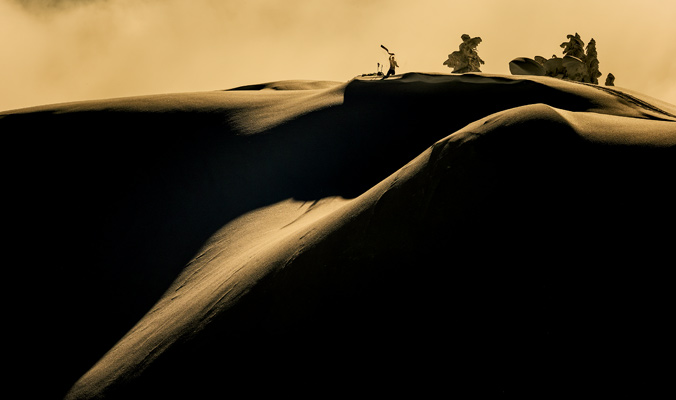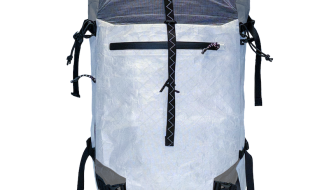
You’re just getting into skinning, intrigued by the prospect of hiking for turns, getting a bit of wintertime fitness and, eventually, possibly heading into avalanche terrain. Right now, however, you’re interested in skinning at ski areas and occasionally beyond them but out of avalanche terrain.
Master This
No. 1 – Skin Like It’s Natural
At first, skinning will feel awkward and robotic. With enough practice, however, it’ll feel as natural as walking. First, ensure your gear is dialed for the climb—bindings in tour mode, poles slightly extended, boots in walk mode with the top buckles and strap loosened to promote cuff mobility and the instep buckles still snug to prevent your feet from sliding around. Then, focus on sliding skis uphill, rather than lifting them off the ground at each step. Propel your front foot forward as though it’s following through from kicking a soccer ball. Skin grip is concentrated underfoot and through the ski’s tail, so focus on standing upright and applying pressure to your heels in order to maintain traction.
No. 2 – Dress Like An Onion
Aerobic activity and winter temperatures can make you a frozen, sweaty mess. But proper layering can easily prevent this. Plan to dress lightly for the ascent: thin, non-cotton baselayers, uninsulated shell pants, a lightweight jacket to fend off wind and a light hat and gloves. Open zippers and vents as necessary to dump heat and minimize sweat. Then add insulation for the way down: a puffy jacket (synthetic is best if you’re sweaty), heavier gloves or mittens, hat/helmet, goggles, etc. Adjust your recipe as necessary and, as you dial it in over a handful of days—and as you continue to hone in your skinning skills and form—your body should feel less like it’s in a sauna, meaning another lap might be in order.
No. 3 – Pack For Access
What goes down must first go up—so only pack what’s necessary and not too much extra. Two liters of water? Only if you plan to be out for a few hours. That five-pound Swiss Army knife? Not worth it unless it has a binding tool. Stick to the essentials: first-aid and repair kits, food and water, a headlamp and layers you actually plan to wear throughout the day, plus an extra warm top. To optimize efficiency and keep moving, pack strategically: bury items less likely to be used at the bottom of a pack while keeping on-the-go essentials, like snacks or a warmer hat, up top in an easy-access pocket or near a main-compartment zipper.
No. 4 – Pace With Consistency
Ski touring isn’t a race; that’s called skimo. Unless you’re in it for the VO2 training or are crunched for time, a conversational pace is best while skinning—and not just for the social aspect. A hurried clip engenders poor form, prompts overheating and can compromise stamina for multiple runs. Instead, keep it steady and smooth. Follow moderately angled slopes and contours, avoiding situations that demand using your binding’s tallest riser whenever possible. If you’re breathing or sweating heavily, back off the pace and incline. It’s more efficient to travel slowly and consistently than to sprint and take repeated breaks—concentrate those rest stops to transitions from climbing to descending (or vice versa), and snack and drink then, as well.
Learn More: Three Resources to Know More
Know Before You Go
Originally developed by the Utah Avalanche Center, Know Before You Go’s avalanche awareness lessons are now shared nationally through free, engaging workshops that highlight the basics of avalanche gear, training, forecasts and more. New this year, Know Before You Go has launched an interactive, online program to complement the classroom curriculum.
SAFE AS Clinics
Founded in 2012 by a group of female professional skiers and guides, SAFE AS clinics are one-day, women’s-specific avalanche safety workshops that combine classroom and on-snow training with morning yoga. These workshops are located in Squaw Valley, Calif. and Stevens Pass, Wash.
Online Academies
Various brands have stepped up with their own forms of mountain education, offering interactive, online workshops, videos, presentations and quizzes. While they’re not really a substitute for in-the-field or classroom knowledge, they can serve as a solid primer to build some background before jumping into your first course.
ortovox.com/safety-academy-lab mountainacademy.salomon.com mountainacademy.atomic.com










Related posts:
2019 Skills Guide: The Level Four Experience
The Snow Pro: Sarah Carpenter is cool with being a snow-science geek
Sheldon Kerr’s Constant Learning
Montgomery Atwater: Father of U.S. Avalanche Work